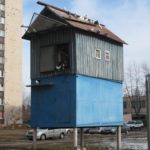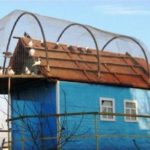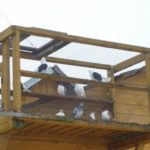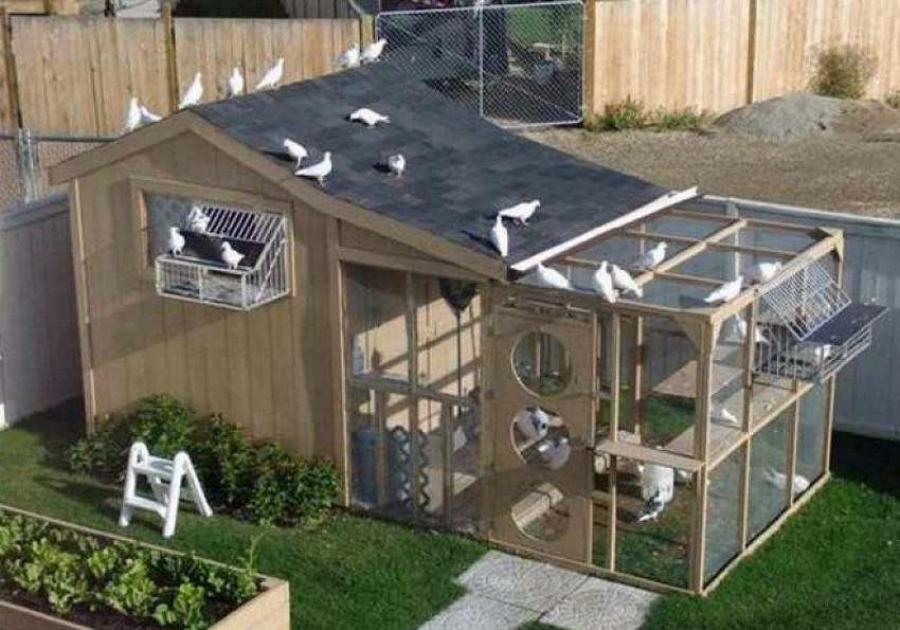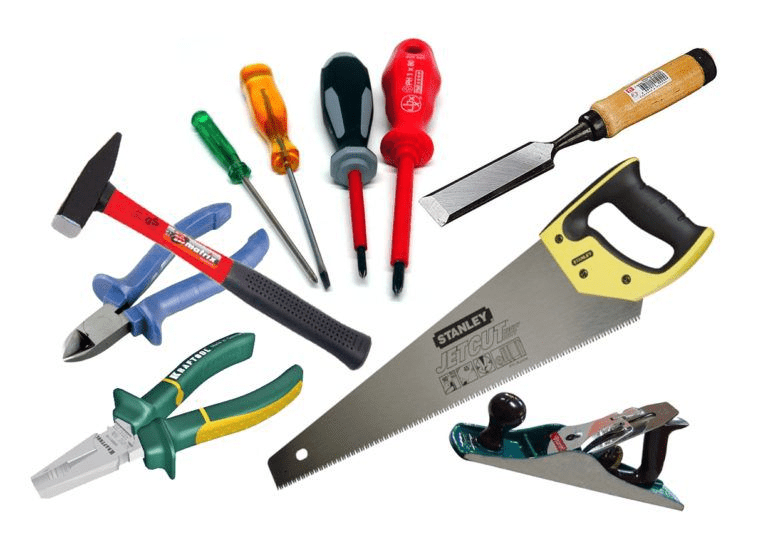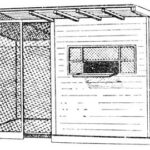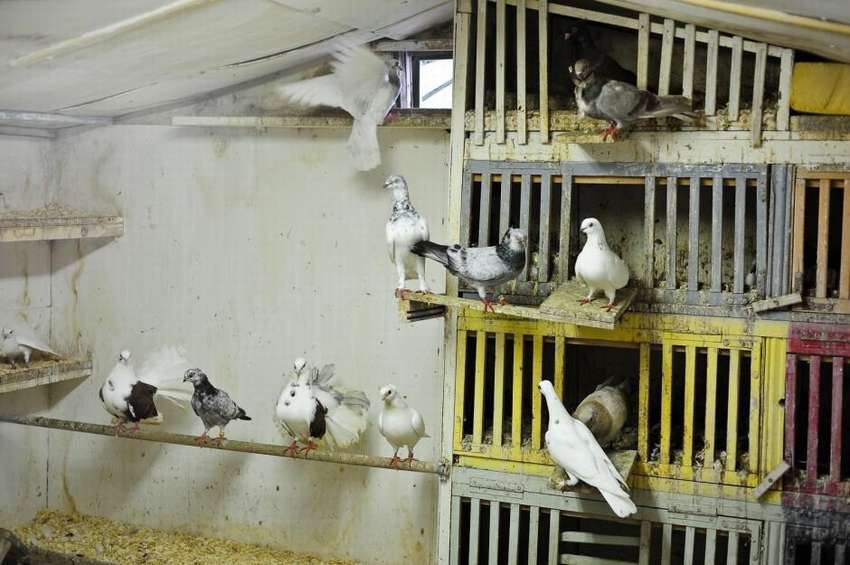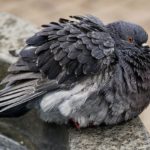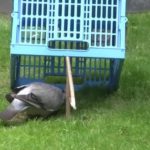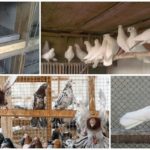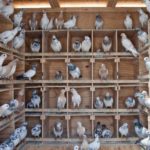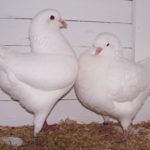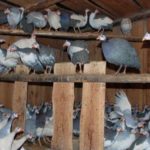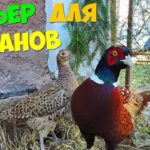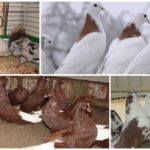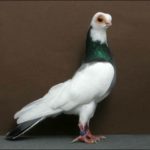The construction and type of poultry house (aviary, dovecote) for pigeons depends on the breed of birds. Domestic pigeons come in sporting (postal), flying, decorative and meat breeds. Each pigeon variety requires its own type of housing. For flying birds, a dovecote is set up on an elevated platform. For meat breeds that cannot fly, a poultry house is built on the ground.
Basic requirements for the structure
When arranging a dovecote, you need to pay attention to the following nuances:
- The poultry house for pigeons must have walls and a roof that does not allow moisture to pass through;
- the room should be spacious, dry and light;
- for pigeons you need to arrange perches on an elevation from the floor;
- It is advisable to install nests for females in darkened areas of the house;
- fresh air should regularly penetrate inside the dovecote;
- there should be no drafts in the room;
- a large poultry house or a small cage must always be kept clean;
- in the dovecote the optimum air temperature should be maintained all year round (from 10 to 20 degrees Celsius);
- It is undesirable to keep birds under an iron roof that gets hot in the heat (overheating is possible);
- It is not recommended to equip heated dovecotes (pampered pigeons have reduced immunity);
- In front of the poultry house for flying birds, a frame is made of wooden slats that do not heat up in the heat, so that the birds can land comfortably.
Types of poultry houses
Each breed of pigeon has its own type of dovecote. The area of the poultry house depends on the number and size of birds, but must be at least one square meter.
Hanging dovecote
Such a poultry house looks like a wooden box, which is attached to the outer wall of the building (shed, outbuilding). At the front of the dovecote there should be a window for entry and a wooden platform for birds to land. You can attach an enclosure made of a metal frame and fine mesh to the wall.
A hanging poultry house is built from simple materials (boards, metal mesh) measuring 0.5 x 1 meter. It is cold inside such a dovecote in winter. The poultry house is designed for 1-2 pairs of birds.
Tower
This is a tower-shaped poultry house, which is located on a high (3-4 meters) iron pole. Such a dovecote is built by pigeon breeders who have about 4 pairs of flying pigeons. Each family is given a separate entry window.Wooden platforms are set up near the windows for pigeons to land. The size of the dovecote is calculated depending on the number of birds. One pair needs an area of 0.5-1 square meters. meter.
Usually they make a tower 1-1.5 meters high and 1.5-2 meters in diameter, which is divided into two floors. Pigeons are always fed outside the poultry house on a platform specially attached to the wall. You can make a pillar dovecote in the form of a rectangle on four pillars (high pipes) for 10-15 pairs of birds.
Such a house for pigeons has a number of advantages: construction materials are cheap, the house takes up little space, and it can be located in any area. The tower dovecote is designed for hardy flying birds. In winter, it is very cold inside such a room. The disadvantages also include some inconvenience for humans (it is difficult to maintain cleanliness in the poultry house, each time you have to lift feed and water up the stairs).
In the attic
Flying breeds of pigeons love to rest on the roof. It is for this reason that it is better to arrange a dovecote in the attic of a building, for example, a barn, stable, or outbuilding. The poultry house should have windows for birds to fly in with platforms for landing and a small door for entry. A person should be able to enter the dovecote and clean it. It is better to make the floor in the poultry house from boards that fit tightly together.
An attic that is too large can be divided into several compartments measuring 2x3 or 3x4 meters. Young pigeons should be kept in one section and old ones in the other.
Aviaries
For decorative pigeons and meat breeds, you can build a poultry house right on the ground. The size of a pigeon house is usually 2x3 or 3x4 meters.The height of the dovecote is 2-3 meters. The booth is installed on a concrete or wooden base. To prevent rotting, the boards are placed on bricks or logs. The poultry house may have several windows for pigeons to enter and a small door for humans to enter.
The area around the booth is fenced with a net to create a walking area. You can install a canopy in the enclosure. The poultry house, located on the ground, is suitable for meat breeds that do not like to fly. Flying pigeons are reluctant to land on low buildings, especially if there are tall buildings or trees nearby.
Some pigeon breeders build a dovecote in the form of a high rectangular enclosure. This type of building has the appearance of a frame covered on all sides with chain-link mesh. Inside the aviary in the upper part there are bird cages.
Tools and materials
To build a dovecote you will need (to choose from):
- floor boards, plasterboard for roof finishing;
- chain-link mesh for the enclosure;
- steel pipe for the tower, diameter 15-30 cm;
- profile metal pipes for the frame;
- bricks, foam blocks or edged boards for walls;
- slate, roof tiles;
- cement mortar;
- expanded polystyrene for wall insulation;
- small plastic windows and doors;
- wooden beam;
- boards for making shelves inside the dovecote;
- wooden planks for perch;
- nails, screws, hammer, screwdriver, hacksaw, tape measure, hammer drill.
How to make a dovecote with your own hands
You can build a poultry house yourself from scrap materials. For flying pigeons, make a dovecote on an elevated surface or equip an attic for it. For meat breeds, a room is built on the ground.
Selecting a location
A dovecote for flying pigeons is built on a hill.It is advisable to choose an open area, not shaded by trees or tall buildings. If there are high-rise buildings near the poultry house, the pigeons will learn to land and rest on them. It is recommended to place the dovecote at a height of 2-3 meters from the ground. Windows for birds to fly in and out should face southeast, as pigeons wake up with the first rays of the sun.
A poultry house for meat breeds can be built on an area intended for outbuildings. The main thing is that there are no electrical wires, cesspools, roads, or crowded places of animals or people nearby. Pigeons are shy, and sudden noise can cause stress in the birds.
Size calculation
When building a pigeon house, adhere to the following size recommendations:
- the area of the dovecote depends on the number of birds (one pair needs 0.5-1 square meter);
- poultry house height - 1-3 meters;
- the size of the window for departure is at least 25x18 cm;
- with a large number of livestock, several departments are made (for old, young birds, young animals);
- for a person to enter the room and individual sections, doors with a height of 1.3 meters are installed;
- The average area of one compartment is 2x3 or 3x4 meters.
Construction stages
The main stages of building a dovecote:
- Construction of a strip foundation, fabrication of a frame.
- Building walls or covering the sides of a frame structure with wood.
- Construction of a roof (gable, single-pitch), waterproofing the top with roofing materials.
- Making the floor.
- Insulation of walls.
- Installation of windows and doors, ventilation.
- Construction of an enclosure from a frame and metal mesh.
Interior arrangement
Perches need to be made inside the poultry house. They are made from planks 2-4 cm wide. Perches for flying birds are equipped with a ladder near the ceiling.For meat breeds, platforms are built at a height of 30 cm from the floor. You can attach wide wooden shelves to the wall, divided into sections on which the birds will spend the night.
Be sure to set up nests in the poultry house. They are made from boxes or wicker baskets. Nests are placed on wide boards, shelves or hung from a wall near which there are no perches. The boxes are placed in such a way that feces from the upper nests do not stain the lower ones.
It is advisable to cover the floor with straw, especially in winter. The litter must be removed when it becomes dirty. Feeders and drinking bowls are installed on the walking area or on a platform near the entrance to the dovecote.
Operating rules
It is advisable to make the dovecote as spacious as possible. Pigeons often fight with each other for perches and nests. The house should have several entrance windows to prevent fights between birds. It is better to arrange the perches in the form of a wooden rack, separated every 30-50 cm by a partition.
The dovecote needs to be cleaned regularly. You can lay straw on the floor to prevent pigeon excrement from staining the boards. Dirty litter is removed 2-3 times a week. Once a month it is recommended to disinfect the premises, that is, treat the floor and walls with disinfectants.
Feeders and drinking bowls are cleaned as they become dirty. In an enclosure located on the ground, you can install a bath for bathing pigeons, and sprinkle some sand nearby. Birds, especially in summer, love to rest on the warm ground, bask in the sun, and swim in the water.




